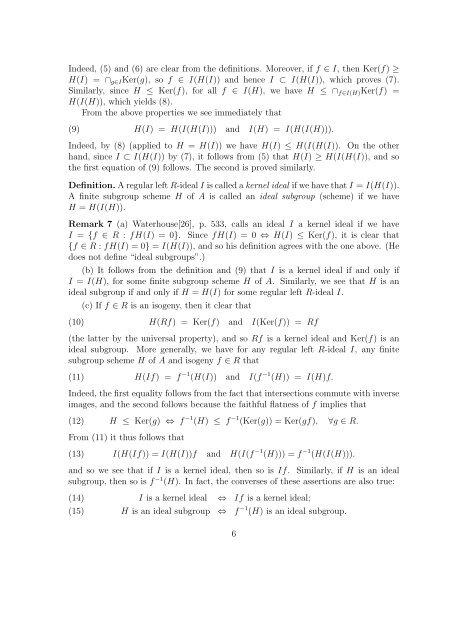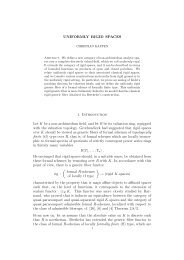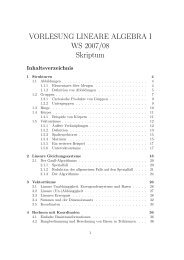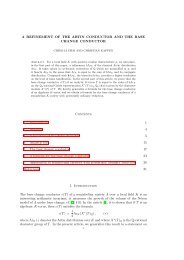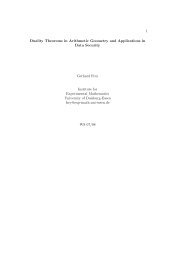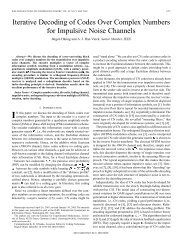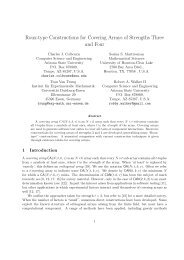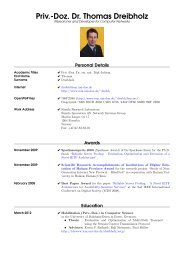Indeed, (5) and (6) are clear from the definitions. Moreover, if f ∈ I, then Ker(f) ≥H(I) = ∩ g∈I Ker(g), so f ∈ I(H(I)) and hence I ⊂ I(H(I)), which proves (7).Similarly, since H ≤ Ker(f), for all f ∈ I(H), we have H ≤ ∩ f∈I(H) Ker(f) =H(I(H)), which yields (8).From the above properties we see immediately that(9)H(I) = H(I(H(I))) and I(H) = I(H(I(H))).Indeed, by (8) (applied to H = H(I)) we have H(I) ≤ H(I(H(I)). On the otherhand, since I ⊂ I(H(I)) by (7), it follows from (5) that H(I) ≥ H(I(H(I)), and sothe first equation <strong>of</strong> (9) follows. The second is proved similarly.Definition. A regular left R-ideal I is called a kernel ideal if we have that I = I(H(I)).A finite subgroup scheme H <strong>of</strong> A is called an ideal subgroup (scheme) if we haveH = H(I(H)).Remark 7 (a) Waterhouse[26], p. 533, calls an ideal I a kernel ideal if we haveI = {f ∈ R : fH(I) = 0}. Since fH(I) = 0 ⇔ H(I) ≤ Ker(f), it is clear that{f ∈ R : fH(I) = 0} = I(H(I)), and so his definition agrees with the one above. (Hedoes not define “ideal subgroups”.)(b) It follows from the definition and (9) that I is a kernel ideal if and only ifI = I(H), for some finite subgroup scheme H <strong>of</strong> A. Similarly, we see that H is anideal subgroup if and only if H = H(I) for some regular left R-ideal I.(10)(c) If f ∈ R is an isogeny, then it clear thatH(Rf) = Ker(f) and I(Ker(f)) = Rf(the latter by the universal property), and so Rf is a kernel ideal and Ker(f) is anideal subgroup. More generally, we have for any regular left R-ideal I, any finitesubgroup scheme H <strong>of</strong> A and isogeny f ∈ R that(11)H(If) = f −1 (H(I)) and I(f −1 (H)) = I(H)f.Indeed, the first equality follows from the fact that intersections commute with inverseimages, and the second follows because the faithful flatness <strong>of</strong> f implies that(12)H ≤ Ker(g) ⇔ f −1 (H) ≤ f −1 (Ker(g)) = Ker(gf), ∀g ∈ R.From (11) it thus follows that(13)I(H(If)) = I(H(I))f and H(I(f −1 (H))) = f −1 (H(I(H))).and so we see that if I is a kernel ideal, then so is If. Similarly, if H is an idealsubgroup, then so is f −1 (H). In fact, the converses <strong>of</strong> these assertions are also true:(14)(15)I is a kernel ideal ⇔ If is a kernel ideal;H is an ideal subgroup ⇔ f −1 (H) is an ideal subgroup.6
Indeed, if If is a kernel ideal, then by the first part <strong>of</strong> (13) we have I(H(I))f =I(H(If)) = If, and so I(H(I)) = I because f is a unit in ˜R ⊃ R. Thus I is a kernelideal, which proves (14). Similarly, if f −1 (H) is an ideal subgroup, then by the secondpart <strong>of</strong> (13) we have f −1 (H(I(H))) = H(I(f −1 (H))) = f −1 (H), and so H(I(H)) = Hby the faithful flatness <strong>of</strong> f. Thus H is an ideal subgroup, which proves (15).(16)(d) For any regular left R-ideal we haveI(H(I)) ⊂ I ∗ := ⋂where the intersection runs over all ˜f ∈ ˜R such that R ˜f ⊃ I. Indeed, if ˜f = f/n withf ∈ R and n ∈ N, then I ⊂ R ˜f implies that In ⊂ Rf and so by (11), (5), (6) and (10)we have that I(H(I))n = I(H(In)) ⊂ I(H(Rf)) = Rf, and hence I(H(I)) ⊂ R ˜f.This verifies (16).In particular, if I = I ∗ , i.e. if I is a divisorial ideal (cf. [5], p. 476), then it followsfrom (8) and (16) that I = I(H(I)). Thus every divisorial ideal is a kernel ideal. Inparticular, if R is commutative, then every invertible R-ideal I is a kernel ideal by[5], p. 118, 476. Thus, if R is a Dedekind domain, then all non-zero ideals are kernelideals.R ˜f⊃I(e) If K ′ /K is any field extension, then we have an injective ring homomorphismR ˜f,β K ′ /K : End(A) → End(A ⊗ K ′ )given by base-change f ↦→ f ⊗ K ′ . If this is surjective (hence an isomorphism), thenit is clear from the definitions that for a finite subgroup scheme H <strong>of</strong> A and R-ideal Iwe haveH(I) ⊗ K ′ = H(β K ′ /K(I)) and I(H ⊗ K ′ ) = β K ′ /K(I(H))because Ker(f ⊗ K ′ ) = Ker(f) ⊗ K ′ , for all f ∈ End(A). Note, however, that ingeneral A ′ := A ⊗ K ′ has more finite subgroup schemes than A, i.e. A ′ may have finitesubgroup schemes which are not <strong>of</strong> the form H ⊗ K ′ .2.2 The invariant I A (B)Given an abelian variety B which is isogenous to A (notation: B ∼ A), we shall definean “invariant” I A (B) which is an isomorphism class <strong>of</strong> left R-ideals, where, as before,R = R A = End(A). This invariant is defined by the ruleI A (B) = Hom(B, A)π = I(Ker(π))where π : A → B is any isogeny.As we shall see presently, the R-module isomorphism class <strong>of</strong> the right hand side doesnot depend on the choice <strong>of</strong> the isogeny π : A → B. For this, we first observe thefollowing.7
- Page 1: Products of CM elliptic curves1 Int
- Page 9 and 10: Indeed, by (18) we have I 1 f = I 2
- Page 11 and 12: Proof. To prove (29), let h ∈ Hom
- Page 13 and 14: 2.4 The quadratic caseWe now specia
- Page 15 and 16: ecause here f 2 |f 1 , so f = f 2 a
- Page 17 and 18: For this, put f = [R ′ : R], I =
- Page 19 and 20: From (54) we can conclude that(55)d
- Page 21 and 22: If H is any finite subgroup scheme
- Page 23 and 24: E. As we shall see, it is very illu
- Page 25 and 26: From this we see on the one hand th
- Page 27 and 28: Proposition 30 Let L ∈ Lat F , wh
- Page 29 and 30: (b) Deuring[10], p. 263. Note that
- Page 31 and 32: integral quadratic formq L,α,β (x
- Page 33 and 34: Corollary 39 Let E 1 /K and E 2 /K
- Page 35 and 36: Proof. Write π i = π Hi : A → A
- Page 37 and 38: (a) The order R is cyclic if and on
- Page 39 and 40: for k = 1, . . . , n − 2. Moreove
- Page 41 and 42: 4.3 Products of CM elliptic curvesW
- Page 43 and 44: Corollary 56 Let E/K be a CM ellipt
- Page 45 and 46: Case 2. char(K) = 0.As was mentione
- Page 47 and 48: Let h A/K (X) ∈ Z[X] (respectivel
- Page 49 and 50: Proof. To prove this, we shall use
- Page 51 and 52: where xy denotes the quadratic form
- Page 53 and 54:
denote the set of isomorphism class


